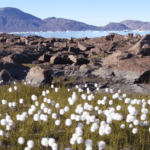A closer look at how dirt freezes and thaws in Canada finds there are still unidentified processes driving emissions of the greenhouse gas nitrous oxide from soil.
Previous laboratory studies have found when soil temperatures hover around the 0⁰C mark, freezing and thawing damages microbial cells and soil particles, causing a release of nitrogen that then gets converted to nitrous oxide. “Our study showed this may not be the case,” says Dr. David Pelster, lead author of a new study in the Canadian Journal of Soil Science.
Pelster and his colleagues at Agriculture and Agri-Food Canada put soil through slower freeze–thaw cycles than previous laboratory studies, more closely replicating what happens in real life on farmed land. They found the soil did not produce any nitrous oxide emissions.
“There are likely other processes driving emissions from the freezing and thawing of soils. Most past studies took soil cores and put them in the freezer before thawing them at temperatures well above zero. This tends to cause more rapid freezing of the soil than what occurs in real life. So, we thought it would be interesting to see if the rate of freezing will affect the soil nitrous oxide emissions,” says Dr. Pelster.
The team took soil samples into their lab and used two freezing and thawing rates, one that was rapid (like many previous lab studies) and one that was much slower (more like what happens on a farm). They found the rapid freezing–thawing did indeed damage the microbial community and soil particles, causing high rates of nitrous oxide emissions.
However, the slow freezing, which was more like real-life conditions, did not produce any nitrous oxide emissions. This was especially surprising because studies in the field where soil thaws at this slower rate do find high emissions.
“So, the big question becomes: why do similar freezing and thawing rates in a lab setting produce results that are so different from a field setting?” says Pelster, “there is more work to be done.”
The team also measured the nitrate (NO3–), nitrite (NO2–), and ammonium (NH4+) concentrations in soils that were frozen and compared them to those of the thawed soils.
“The interesting thing was that there was not much change in the nitrate and ammonium concentrations; however, there was a large change in the nitrite concentrations regardless of whether the soils were thawed rapidly or slowly. As nitrite is related to nitrous oxide emissions, we think the increase of nitrite may be related to the emissions we often see when soil thaws in real life. This gives us a clue as to where to focus future research,” says Pelster.
With a warming climate, we can expect more freeze–thaw cycles across Canada and other temperate regions as snow cover—which happens to be an excellent insulator, like a blanket—diminishes. This means more nitrous oxide emissions from soils and a greater need for continued studies to understand these mechanisms and to build solutions for the future.
Read the paper: Rates and intensity of freeze–thaw cycles affect nitrous oxide and carbon dioxide emissions from agricultural soils in the Canadian Journal of Soil Science.




